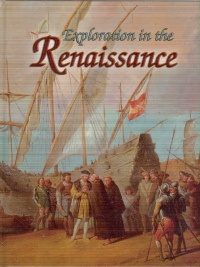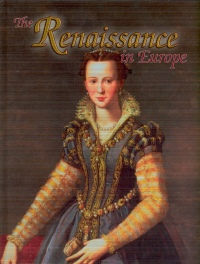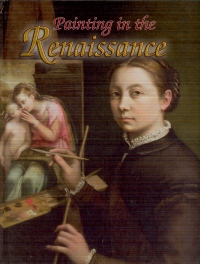| ________________
CM . . .
. Volume XV Number 22. . . .June 26, 2009 
 |
Exploration in the Renaissance (Renaissance World).
Lynne Elliott.
St. Catharines, ON: Crabtree, 2009.
32 pp., pbk. & hc., $9.95 (pbk.), $20.76 (hc.).
ISBN 978-0-7787-4611-3 (pbk.), ISBN 978-0-7787-4593-8 (hc.).
Subject Headings:
Renaissance-Juvenile literature.
Europe-Civilization-Juvenile literature.
Discoveries in geography-Europe-Juvenile literature.
Grades 4-6 / Ages 9-11.
Review by Harriet Zaidman.
**1/2 /4
|
| |
|
 |
The Renaissance in Europe (Renaissance World).
Lynne Elliott.
St. Catharines, ON: Crabtree, 2009.
32 pp., pbk. & hc., $9.95 (pbk.), $20.76 (hc.).
ISBN 978-0-7787-4611-9 (pbk.), ISBN 978-0-7787-4591-4 (hc.).
Subject Headings:
Renaissance-Juvenile literature.
Europe-Civilization-Juvenile literature.
Grades 4-6 / Ages 9-11.
Review by Harriet Zaidman.
**1/2 /4
|
| |
|
 |
Painting in the Renaissance. (Renaissance World).
Una D'Elia.
St. Catharines, ON: Crabtree, 2009.
32 pp., pbk. & hc., $9.95 (pbk.), $20.76 (hc.).
ISBN 978-0-7787-4612-6 (pbk.), ISBN 978-0-7787-4592-1 (hc.).
Subject Heading:
Painting, Renaissance-Juvenile literature.
Grades 4-6 / Ages 9-11.
Review by Harriet Zaidman.
**1/2 /4
|
| |
|
 |
Science in the Renaissance. (Renaissance World).
Lisa Mullins.
St. Catharines, ON: Crabtree, 2009.
32 pp., pbk. & hc., $9.95 (pbk.), $20.76 (hc.).
ISBN 978-0-7787-4614-0 (pbk.), ISBN 978-0-7787-4594-5 (hc.).
Subject Heading:
Science, Renaissance-Juvenile literature.
Grades 4-6 / Ages 9-11.
Review by Harriet Zaidman.
**1/2 /4
|
| |
|
8
excerpt:
Botany, the study of plants, and zoology, the study of animals, were both very popular during the Renaissance. European explorers in the Americas, Africa, India, and the Far East of Asia observed and brought back many new plants and animals that were previously unknown to Europeans…Botany grew in popularity during the Renaissance as many new species of plants were discovered and bought back by explorers…The gardens were filled with ordinary European plants and flowers, as well as plants and flowers brought back from the Americas and India. (From Science in the Renaissance.)
These three sentences, which all say the same thing, appear on the same page of a two-page chapter spread called 'Plants and Animals' in Science in the Renaissance. The information is not so earth shattering that students need it to be repeated three times before they can absorb it. More useful would be several examples of plants that were imported from far away that are now in common use in Europe and North America, or animals that now inhabit these regions.
The simplistic approach to the topic and the simplistic style of writing, combined with other competently written chapters in these four books, make this an uneven series. Moreover, Crabtree Publishing has a tendency to put a higher age recommendation on the books than they really deserve. Crabtree claims that the "Renaissance World" series is purportedly good for students up to grade 8, but it is more suited to children in grades 4-6. Junior high students are mature enough to understand advanced explanations and specific information. They are able to handle more depth and elucidation and should be challenged if they are to be able to handle adult-level material they will be reading when they get to high school.
The Renaissance is a fascinating period in history. The advances in science and culture captivate young people, whether they study it in class or read about it on their own. The books in this series are designed to attract, with paintings from the era on the cover, antiqued background colours on the pages and interesting topics. The content is illustrated through examples of more Renaissance-era paintings, drawings or maps, giving children a wide exposure to art found in museums all over the world.
So it's a disappointment that the topics are not substantially explained. Another example is the definition of a caravel. It was a ship, and its qualities came in handy steering along coastlines. The usefulness of the caravel is attributed to the type of sails with which it was fitted, but in none of the books does the text point out that the hull of this ship was not as deep as other ships, and, therefore, it could sail safely along shallow and potentially rocky coastlines. This is a key piece of information about a ship. It was readily available on the Internet, but not in these books.
Some of the books are better than the others – notably Painting in the Renaissance and various chapters in other volumes. Despite its appealing look, the "Renaissance World" series should serve as an adjunct only to a teaching unit on the era, but it is not of enough value to recommend as a must-buy.
Recommended with reservations.
Harriet Zaidman is a teacher-librarian in Winnipeg, MB.

To comment
on this title or this review, send mail to cm@umanitoba.ca.
Copyright © the Manitoba Library Association. Reproduction for personal
use is permitted only if this copyright notice is maintained. Any
other reproduction is prohibited without permission.
NEXT REVIEW |
TABLE OF CONTENTS FOR THIS ISSUE
- June 26, 2009.
AUTHORS |
TITLES |
MEDIA REVIEWS |
PROFILES |
BACK ISSUES |
SEARCH |
CMARCHIVE |
HOME |



